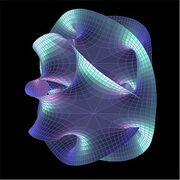
String theory is a set of attempts to model the four known fundamental interactions—gravitation, electromagnetism, strong nuclear force, weak nuclear force—together in one theory. This approach to resolving the alleged conflict between classical physics and quantum physics seeks to quantize—in other words, describe in terms of elementary units—the one classical force: gravity, yet also to develop a new quantum field theory of the other three fundamental interactions.
The term 'string theory' properly refers to both the 26-dimensional bosonic string theories and to the 10-dimensional superstring theories discovered by adding supersymmetry. Nowadays, 'string theory' usually refers to the supersymmetric variant while the earlier is given its full name, 'bosonic string theory'. Template:String-theory Interest in string theory is driven largely by the hope that it will prove to be a theory of everything. It is one viable solution for quantum gravity, and in addition to gravity it can naturally describe interactions similar to electromagnetism and the other forces of nature. Superstring theories also include fermions, the building blocks of matter. It is not yet known whether string theory is able to describe a universe with the precise collection of forces and matter that we observe, nor how much freedom to choose those details the theory will allow.
On a more concrete level, string theory has led to advances in the mathematics of knots, Calabi-Yau spaces and many other fields. Much exciting new mathematics in recent years has its origin in string theory. String theory has also led to much insight into supersymmetric gauge theories, a subject which includes possible extensions of the standard model.